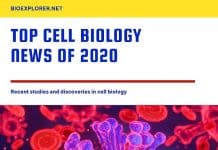
Nondisjunction: Meiosis is the fundamental process that is behind sexual reproduction[1] with the formation of offspring that are genetically unique from each other and ever from their parents.
While meiosis certainly evolved from mitosis itself, the former had acquired few novel steps that are distinct from the latter: pairing of the homologous chromosomes, recombination between non-sister chromatids, inhibition of the separation of sister chromatids during meiosis I, and the absence of replication of chromosomes during meiosis II.
In living organisms, the process of meiosis is very accurate and tightly regulated; however, accidents sometimes happen when the chromosomes fail to separate correctly.
Table of Contents
(Note: In case you missed the chromosomal mutations, check it out).
Mechanism of Nondisjunction
- Usually, this phenomenon is caused by the failure of the separation of homologous chromosomes during anaphase I or the sister chromatids during anaphase II.
- If the error occurred during anaphase I, the result is the presence of two gametes with a lacking chromosome and two gametes that bear two copies of the chromosome. Meanwhile, when the error occurred at anaphase II, the result is one gamete lacking a chromosome, another gamete that bears two copies of the chromosome, and two normal gametes that each have a copy of the chromosome.
- In most cases, when a normal gamete is combines with a gamete that has acquires an additional chromosome from nondisjunction, the resulting zygote is referred to as trisomic . On the other hand, when there is only one chromosome from a pair, the cell is considered to be monosomic. Both cases are considered to be aneuploidy[3] , or the abnormal number of chromosomes in the cell.
The diagram below illustrates the difference between the normal process of disjunction versus nondisjunction in chromosome 21:

![]()
Disorders Caused By Nondisjunction
Tabulated below are the disorders that are manifested by individuals who bear chromosomes that underwent nondisjunction.
| TYPE OF DISORDER | ABNORMALITY | NUMBER OF CHROMOSOMES | CHARACTERISTICS |
|---|---|---|---|
| Down Syndrome | Trisomy 21 (presence of a third copy of chromosome 21) | 47 | Individuals with this syndrome are often called as “mongoloids“[5] due to their physical attributes similar to the Mongolian descent: flat face, slanting eyes, short neck, below average intelligence, etc. |
| Edwards Syndrome | Trisomy 18 (presence of a third copy of chromosome 18) | 47 | Individuals with Edwards syndrome[6] are characterized by their small and abnormally shaped head, small jaw, clenched fists and fingers that tend to overlap. |
| Patau Syndrome | Trisomy 13 presence of a third copy of chromosome 13) | 47 | Among the three autosomal trisomies, this is the rarest yet the most severe[7]. Individuals are characterized by having polydactyly (having extra fingers or toes), holoprosencephaly (failure to create double lobes of the cerebral hemispheres), facial clefting, heart ailments, etc. |
| Turner Syndrome | Absence of one X chromosome | 45 | Only affecting females, Turner syndrome[8] is characterized by the offspring having short stance, inability to develop during puberty, infertility, heart ailments, and other physical, social, and mental disabilities. |
| Metafemale | Presence of extra X chromosome (XXX) | 47 | This syndrome is also referred to as the Triple X syndrome[9] as affected individuals (known as metafemales) are characterized by the presence of an extra X chromosome. Most of the time, metafemales do not exhibit unusual physical attributes but they can be described as having behavioral problems, wide-set eyes, and ovarian failure. |
| Klinefelter Syndrome | Presence of extra X chromosome (XXY) | 47 | Klinefelter Syndrome[10] only occurs in males (due to the presence of the X chromosome) and it specifically affects their physical and intellectual development. In most cases, affected individuals have small reproductive organs and produce less testosterone than normal. This can then lead to delayed puberty and expression of some female physical attributes like the enlargement of breasts. |
| Jacob’s Syndrome | Presence of extra copy of the Y chromosome (XYY) | 47 | Individuals with the Jacob’s syndrome[11] appear to be physically normal in general. Because of their excess Y chromosome, they are taller than average, weaker muscle tone, and may have some learning and speech problems. |
Due to the presence of numerous severe life-threatening medical problems, many individuals with trisomies or nondisjunction in their autosomal cells die either before birth or within their first month.
On the other hand, the last four syndromes may be fatal[12] but sometimes, offspring with these kinds of genotype may appear just fine.
- According to studies, nondisjunction tends to occur more commonly in the cells of older individuals. This is precisely because the cell tends to lose its complete control over some processes as it grows older.
- This fact is observed by the fact that women who get pregnant at an older age are more likely to conceive children who are affected by the aforementioned disorders.
Check out this video that explains how offspring can have the wrong number of chromosomes. You will learn how individuals are born with Down, Turner’s, and Klinefelter’s syndromes.
![]()
Despite the immense knowledge about the molecular process of meiosis, two major questions still puzzle scientists: why in the first place meiotic nondisjunction emerged and why hasn’t evolution removed such a detrimental phenomenon? Therefore, this topic is still up for future studies.

















